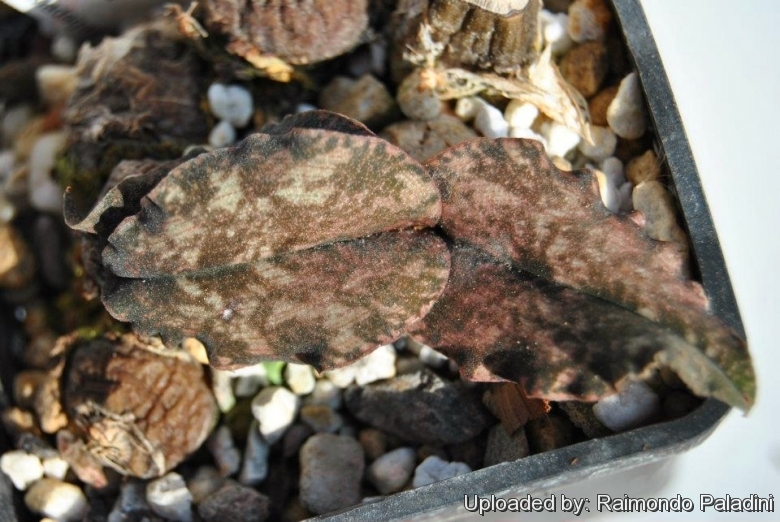= Oeceoclades roseovariegata (Senghas) Garay & P.Taylor
Bot. Mus. Leafl. 24: 270 (1976).
Accepted Scientific Name: Oeceoclades gracillima (Schltr.) Garay &
Bot. Mus. Leafl. 24: 262 (1976)

Eulophidium roseovariegatum (Oeceoclades roseovariegata) Photo by: Raimondo Paladini
Origin and Habitat: Oeceoclades roseovariegataSN|32987]]SN|32987]] occurs in southern and western Madagascar (Antsiranana, Mahajanga). The type species comes from near Diego Suarez, Montague des Francaise.
Habitat and ecology: This species is found growing in deciduous forest and woodland on limestone or on siliceous areas, often in the shade of the baobab trees, in an area that is seasonally arid, but does have frequent heavy night fogs.
Synonyms:
See all synonyms of Oeceoclades gracillima
back
Accepted name in llifle Database:Oeceoclades gracillima (Schltr.) Garay &Bot. Mus. Leafl. 24: 262 (1976)Synonymy: 6
back
Common Names include:
ENGLISH: Jewel Orchid, Variegated Rose Oeceoclades, Snake Orchid
Description: Oeceoclades roseovariegataSN|32987]]SN|32987]], is generally included within (as a synonym of Oeceoclades gracillimaSN|32983]]SN|32983]], suggesting that there is not really a fundamental difference between the two. It is an interesting terrestrial orchid, from Madagascar, primarily grown for its foliage reminding of pink and red coloured snake skin. The leaves have a cryptic colour pattern, it is almost invisible when placed on a layer of dead leaves and rocks. The flowers are small, odourless and insignificant greenish brown with a white inner with pink spots; by and far the most interesting aspect of this plant are the leaves. It was first described by the German botanist Rudolf Schlechter under the illegitimate name Eulophia gracillimaSN|32986]]SN|32986]] in 1913. Schlecter later validly republished the species under the name Eulophidium gracillimumSN|32984]]SN|32984]] in 1925. It was then moved to the genus Oeceoclades by Leslie Andrew Garay and Peter Taylor in 1976. Oeceoclades roseovariegataSN|32987]]SN|32987]] differs from the typical variety in its slightly larger size, longer stem, larger leaves and larger flowers.
Derivation of specific name: The epithet 'roseovariegata': rosy + variegated, refers to the pink and silver mottled, variegated leaves.
Pseudobulbs: Small (2.3 x 1 cm) very compressed, round or ovoid, the most recent bearing the inflorescence.
Leaves: 2, diverging, topping the pseudobulbs and somewhat hugging the ground. The leaves are ovate-oblong, thick and leathery (1.5-)1.7-2.5(-3) cm wide and (2.5-)3-7.5(-11) cm long, dark green-purple, heavily , tessellated, striped silver and pink on the top. Margins corrugate-crisped. The leaf surface is also rather unusual for an orchid, it seems to be covered with a very fine felt or has minute projections, but it is not "hairy".
Inflorescences (panicles): 6-10 per stem each 30-50 cm tall, thin, simple or 2-3 branched and carrying 6 to 10 flowers. Peduncle slightly shorter than the branches bracts lanceolate-accumulate, not more than one-quarter the length of the petiole.
Flowers. Small, brownish 10-12(-18) mm long. Sepals narrow, oblong-lingulate, obtuse, about 4 mm long, the laterals slightly arched. Petals oblong-obtuse, wider and slightly shorter (3 mm) green-yellow overlaid brown-purple widely flattened basally, trilobed to nearly the middle, lateral lobes obtuse, the median truncate, slightly longer, retuse apically; with 2 discoid calluses near the base: spur connical, subacute, 3.5 mm long. The labellum (3 x 3 mm) is white with red-purple marks and veins. Column with a short nearly absent foot. Anther slightly gibbous behind. Pedicel generally 7 mm long.
Flowering season: (in habitat) March-June, November.
Bibliography: Major references and further lectures
1) David Du Puy, Jean Bosser “Orchids of Madagascar” Royal Botanic Gardens, 2007
2) Phillip Cribb, Johan Hermans “Field Guide to the Orchids of Madagascar” Royal Botanical Gardens, Kew, 2009
3) “Some Unusual Terrestrial Orchids” Pollinia, Volume 10, Issue 2-3 The Irish Orchid Society January 2012
Cultivation and Propagation: This plant prefers bright light and drier conditions. This equates to conditions similar to Cattleya. Seems to be an easy grower, though it grows quite slowly.
Substrate. Fir bark, pine bark, perlite and hort charcoal mix.
Water requirements. Water about once a week.
Exposure. Grow it year round in the brightest location but not in full blazing sun.








